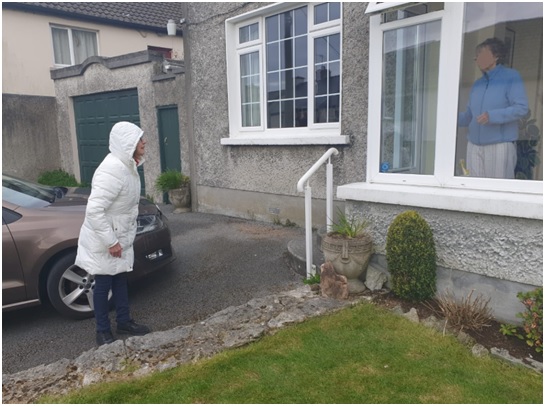Tips on communicating through windows during the Covid-19 crisis.
We all appreciate the importance of social distancing at this stage, but what do we know about the acoustics of the “new normal” of communicating through windows when visiting neighbours?

It seems obvious, but we should all remember that we must have some part of the window open to even attempt communicating through a window. But there’s much more to it than that. Diarmuid Keaney of ICAN Acoustics (www.acoustics.ie) has prepared some useful guidelines to help with the communication process, improving speech intelligibility and making the overall experience acoustically better and more comfortable for everyone.
His 10 top tips are as follows:
1. Try to use a window that’s not near any major sources of noise. For example, if the front windows of your home are close to a road, then consider using rear windows which may be in a quieter location.
2. Use rooms inside the house that are relatively quiet too, such as bedrooms or rooms where activity is low. A kitchen occupied by others is not ideal, for example; an empty bedroom can provide a much better environment.
3. Turn off TVs, radios or anything else in the home that could interfere with conversation. Even another house member vacuuming in an adjacent room can be problematic.
4. Ensure that the person inside the property speaks towards the window opening, as our voices do have directionality and when we face the opening, it increases audibility and intelligibility.
5. When we open a top hinged or side hinged window, we need to consider the partially open window pane as an acoustic reflector. The listener outside needs to position themselves close to where the sound will be reflected. To help visualise this, imagine a ping-pong ball projecting from a person’s mouth inside, striking the glazing in the partially open window and bouncing off that and reflecting in the direction of the listener. The listener’s ear should be in line with the directly reflected ping-pong ball.
6. Both parties – inside and out – should move close to the window opening whilst still maintaining safe distancing.
7. Both parties should speak loudly to help overcome the effects of the glazing and its opening.
8. Be mindful of your conversational privacy and remember that the person speaking at an elevated level externally is likely to be easily overheard by others nearby.
9. Don’t underestimate the amount of information that listeners get from your mouth movements, and ensure that listeners can see your mouth clearly when speaking. The movement of our mouths is vital in terms of assisting with understanding in difficult acoustic arrangements. Sometimes a table lamp on an internal window sill can help in this regard,by ensuring the person inside is well illuminated.
10. Keep in mind that elderly people whose hearing may be degraded under normal circumstances may not have any chance of communicating through a window. In cases where there is a history of hearing loss, then a mobile phone call across the window might be a better arrangement.
Acoustic consultancy regularly considers sound level, sound transmission, speech intelligibility, sound insulation, background noise and noise transfer. The 10 tips discussed above are a sample of some of the benefits of acoustics when applied to one of the many challenges presented by Covid-19. Hopefully these tips might make life a little simpler for someone in your life.
